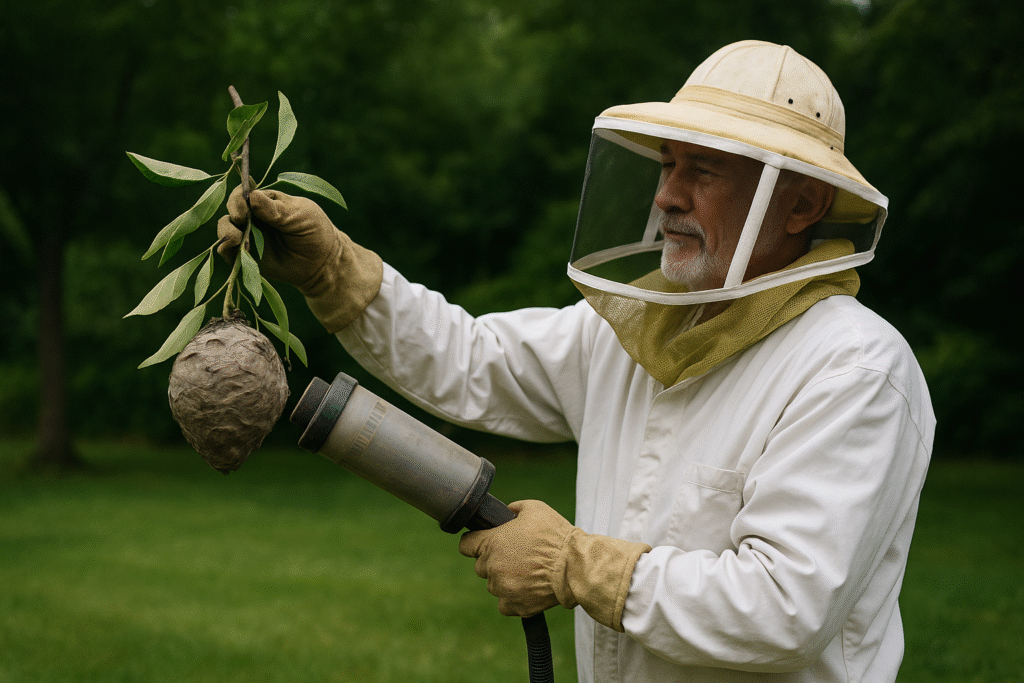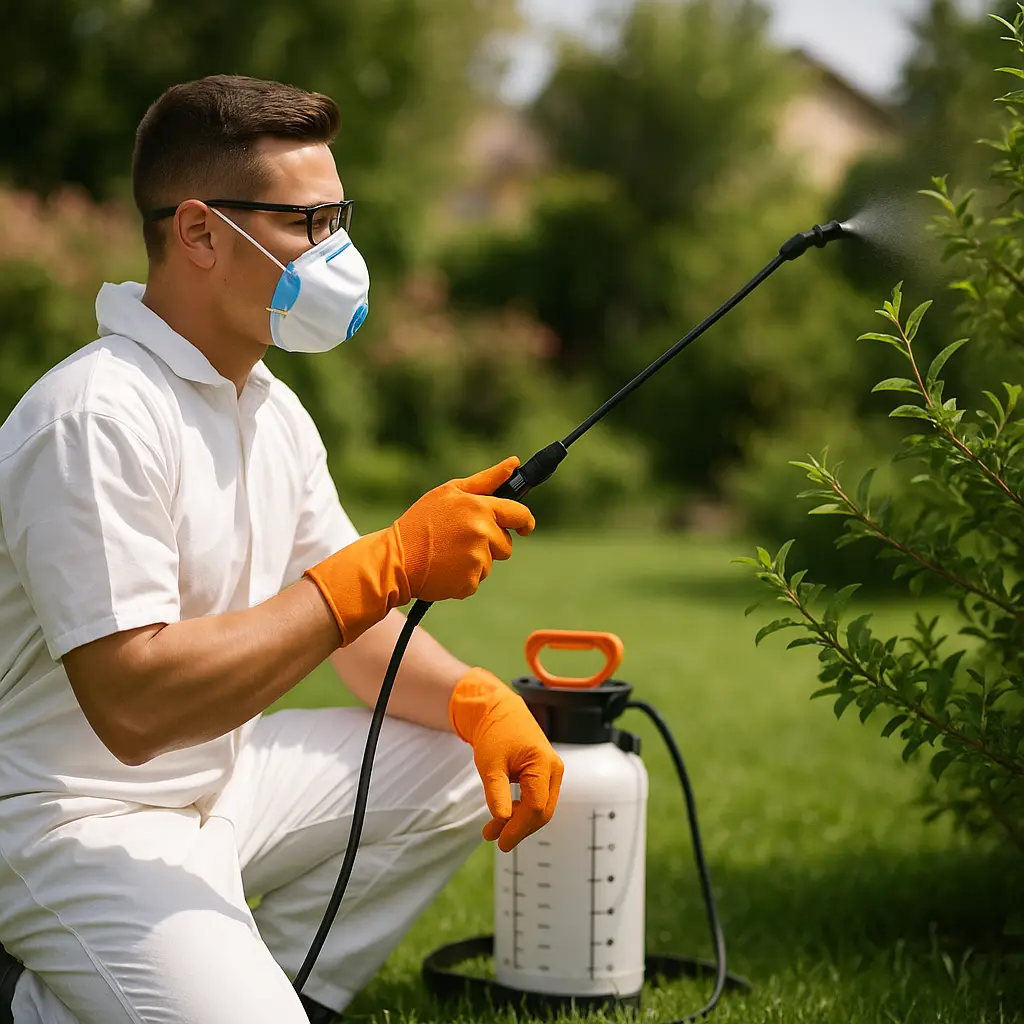Spotting the Signs of a Wasp Nest in Your Garden
We’ve all been there, enjoying a beautiful sunny day in the garden, when suddenly a wasp flies a little too close for comfort. One or two might be a fluke, but once they show up regularly, it’s time to start looking for the source. Wasps love quiet, sheltered spots, which makes our homes and gardens the perfect places to set up nests. Garages, garden sheds, lofts, roof eaves, and even bushes can all become home to a wasp colony.
Look around during midday when wasps are most active. You might notice a few heading in and out of the same hole or crack. That’s your first clue. If you hear a low buzzing noise or see papery-looking grey or brown structures, that confirms it, you’ve got a wasp nest nearby.
If you want to stop an infestation before it becomes dangerous, act quickly. The sooner we identify and target the nest, the easier and safer it’ll be to sort it out.
Is It Safe to Remove a Wasp Nest Yourself?
We always want to avoid letting a problem get out of hand. But as tempting as it may be to grab a broom or blast it with a hose, that’s not the best idea.
Wasps are not friendly creatures when disturbed. A swarm can sting multiple times, which is not only painful but potentially dangerous for anyone allergic. That’s why we stress safety first. If the nest is large, high up, or inside your walls or roof, it might be best to ask professionals instead of risking your health.
Still, many small nests around your garden can be dealt with safely on your own, as long as you follow careful steps and proper timing. Wasps-R-Us always focuses on safe control methods, and with our guide, you’ll know exactly how to handle it yourself or when to call someone in.
The Best Time to Remove a Wasp Nest
Timing makes all the difference. Wasps rest during the cooler hours, so early morning or late evening is the best time to tackle the job. At these times, most of the wasps are inside the nest and are much less active. They’re slower and not flying around as much, which means they’re less likely to sting if you disturb them.
Avoid broad daylight removal attempts. That’s when wasps are aggressively protecting the nest. We always wear protective layers when approaching a nest during dusk or dawn, and we make sure pets and family members are kept far away.
If you do need professional support at any point, go ahead and check out this expert wasp control service at Wasp Nest Removal UK.
DIY Steps to Remove a Wasp Nest Safely
Let’s walk through the steps we use to safely deal with wasp nests around our own homes. With careful planning and a calm method, we can sort it with confidence.
- Wear Protective Clothing
We always put on thick clothes, long sleeves, gloves, and cover our faces if possible. A bee suit or heavy gardening gear works perfectly to protect against stings. - Pick the Right Tool
Get a wasp-specific insecticide spray from your local shop. Look for one that shoots long-range foam or spray. These stops wereps from escaping during your approach. Always follow the instructions carefully. - Approach at Dawn or Dusk
As mentioned, this is when wasps are least aggressive. Move slowly and quietly without drawing their attention. - Use the Spray from a Distance
Aim directly at the nest opening. Spray for the length of time stated on your spray can. It quickly immobilises and kills the wasps inside. - Wait and Watch
Leave the nest alone for 24 hours. Return later and check from a distance. If there’s no movement, the nest is likely inactive. - Remove the Empty Nest
Once all activity stops, use a pole or stick to knock it down. Place it in a sealed bin bag and throw it away safely. - Seal Entry Points
Stop more wasps from coming back by sealing any holes, gaps, or wall cracks where the nest was built. You can use foam filler, caulk, or mesh wire.

When to Call in the Pros
Sometimes, it’s just not worth the risk. If the nest is too high, hard to reach, or deep in your wall cavities, leave it to the experts. Large nests often house hundreds, sometimes thousands, of wasps. That’s not something to tackle solo, no matter how brave we feel.
At Wasp Nest Removal UK, trained professionals come fully prepared with equipment and chemicals designed to handle big wasp problems. They’re quick, discreet, and guarantee safe removal. We’ve had great experiences working alongside their team when customers needed extra help. Wasps-R-Us always values safe solutions that work fast.
Preventing Future Nests in Your Garden
After dealing with one nest, we all want to make sure it never happens again. Keeping your space unattractive to wasps is the best way to avoid a repeat invasion.
- Keep bins sealed and away from doors: Wasps love food waste.
- Close holes in walls or roof tiles: These spots attract wasps looking to build.
- Trim back thick bushes and hedges: These natural hiding spots are perfect for early nest-building.
- Install wasp deterrents: Citronella candles, peppermint oil, or fake decoy nests can keep new colonies at bay.
- Check sheds and attic spaces often: A quick inspection now avoids a problem later.
Even with all these tips, wasps can still sneak in. That’s why we always keep the number for Wasp Nest Removal UK handy, just in case a stubborn colony takes hold.
FAQs
Can I knock down a wasp nest with a stick or broom?
Never do this. It might feel like a quick way to get rid of it, but it only makes the wasps angry and ready to sting.
Will a home-made trap work?
Traps with sugar water or vinegary bait can draw some wasps away, but they won’t solve the root problem if a nest is nearby.
Is it legal to kill wasps in the UK?
Yes, you can remove or treat nests on your property. Just make sure it’s done safely.
How do I know the nest is empty?
If there’s no visible wasp activity for 24-48 hours, it usually means the nest is no longer active.
Does smoke drive wasps away?
Smoke can confuse or disturb wasps, but it rarely clears a full nest and often doesn’t kill them. It’s safer to use a proper pesticide spray.
Summary & What to Do Next
Having wasps around your garden can turn peaceful afternoons into stressful battles. The sooner we take action, the easier it is to manage. Whether we’re tackling it ourselves or calling in the team at Wasp Nest Removal UK, the key is staying calm, being prepared, and acting before they grow too large in number.
Always wear proper protection, follow safety steps, and don’t be afraid to call for help. With our guide and help from Wasps-R-Us experts, you’re well on your way to a wasp-free garden.
If there’s a buzzing nest behind your shed, in the loft, or near your front door, don’t wait around. Grab your gear or get fast local help at Wasp Nest Removal UK, your safest route to reclaiming your home.



 Blog
Blog